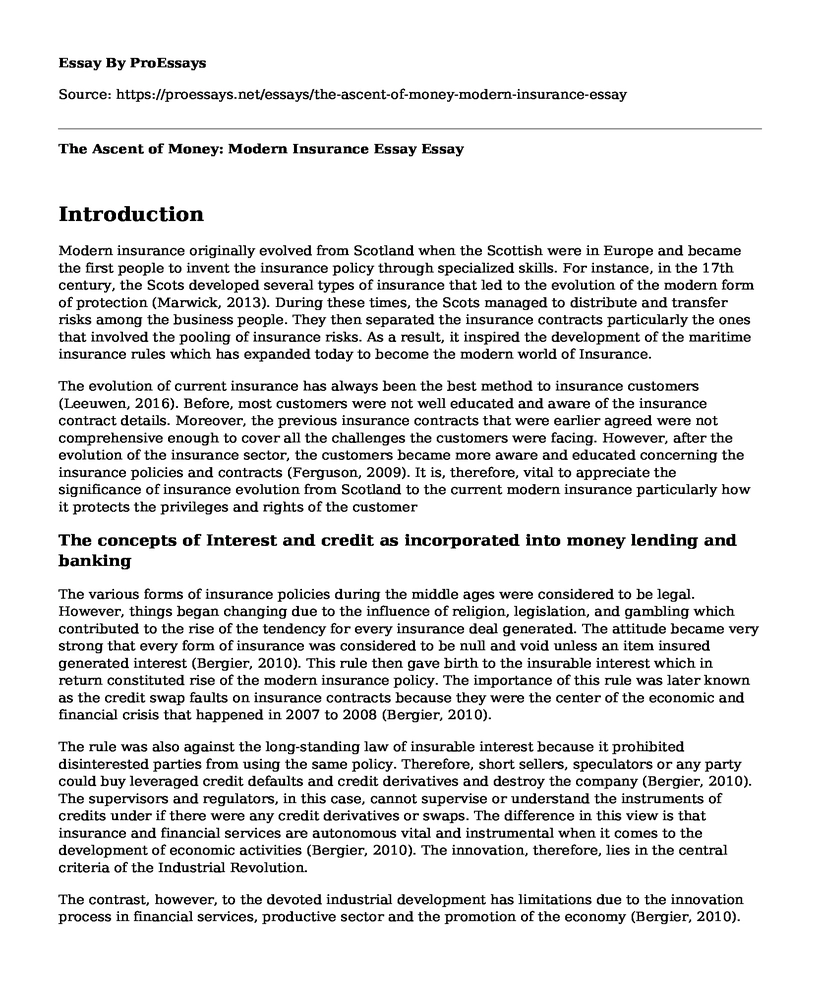Introduction
Modern insurance originally evolved from Scotland when the Scottish were in Europe and became the first people to invent the insurance policy through specialized skills. For instance, in the 17th century, the Scots developed several types of insurance that led to the evolution of the modern form of protection (Marwick, 2013). During these times, the Scots managed to distribute and transfer risks among the business people. They then separated the insurance contracts particularly the ones that involved the pooling of insurance risks. As a result, it inspired the development of the maritime insurance rules which has expanded today to become the modern world of Insurance.
The evolution of current insurance has always been the best method to insurance customers (Leeuwen, 2016). Before, most customers were not well educated and aware of the insurance contract details. Moreover, the previous insurance contracts that were earlier agreed were not comprehensive enough to cover all the challenges the customers were facing. However, after the evolution of the insurance sector, the customers became more aware and educated concerning the insurance policies and contracts (Ferguson, 2009). It is, therefore, vital to appreciate the significance of insurance evolution from Scotland to the current modern insurance particularly how it protects the privileges and rights of the customer
The concepts of Interest and credit as incorporated into money lending and banking
The various forms of insurance policies during the middle ages were considered to be legal. However, things began changing due to the influence of religion, legislation, and gambling which contributed to the rise of the tendency for every insurance deal generated. The attitude became very strong that every form of insurance was considered to be null and void unless an item insured generated interest (Bergier, 2010). This rule then gave birth to the insurable interest which in return constituted rise of the modern insurance policy. The importance of this rule was later known as the credit swap faults on insurance contracts because they were the center of the economic and financial crisis that happened in 2007 to 2008 (Bergier, 2010).
The rule was also against the long-standing law of insurable interest because it prohibited disinterested parties from using the same policy. Therefore, short sellers, speculators or any party could buy leveraged credit defaults and credit derivatives and destroy the company (Bergier, 2010). The supervisors and regulators, in this case, cannot supervise or understand the instruments of credits under if there were any credit derivatives or swaps. The difference in this view is that insurance and financial services are autonomous vital and instrumental when it comes to the development of economic activities (Bergier, 2010). The innovation, therefore, lies in the central criteria of the Industrial Revolution.
The contrast, however, to the devoted industrial development has limitations due to the innovation process in financial services, productive sector and the promotion of the economy (Bergier, 2010). Several considerations were also considered in the financial services including insurance that has been successful and innovative by the international standards influenced positively by the relationship between the financial economic and innovation growth (Ross et al., 2016). Therefore, the concepts of Interest and credit as used in today's financial sector signifies the security in insurance during registration. This guarantees the customers of reimbursement in case of any challenge because the coverage has enough funds to sustain the business.
References
Bergier, J. (2010). The resurgence during the Middle Ages: The confused dynamics of the Middle Ages. Political Competition, Innovation, and Growth, 127-140. doi:10.1007/978-3-642-60324-2_10
Leeuwen, M. H. (2016). The Rise and Decline of Modern Trade Union Insurance, 1900-65. Mutual Insurance 1550-2015, 167-217. doi:10.1057/978-1-137-53110-0_4
Marwick, W. H. (2013). Scotland in Modern Times. 333-367. doi: 10.4324/9781315031774
Ferguson, N. (2009). The ascent of money [Video file]. Retrieved from https://www.youtube.com/watch?v=KdENsIkBpiY
Ross, S. A., Westfield, R., Jordan, B. D., & Roberts, G. S. (2016). Fundamentals of corporate finance (9th Canadian Ed.). Whitby, Canada: McGraw-Hill Ryerson.
Cite this page
The Ascent of Money: Modern Insurance Essay. (2022, Aug 18). Retrieved from https://proessays.net/essays/the-ascent-of-money-modern-insurance-essay
If you are the original author of this essay and no longer wish to have it published on the ProEssays website, please click below to request its removal:
- Coursework Example on Advertising Budget
- Rebuilt Title Car Isn't Bad Essay Example
- Essay on ERISA: Regulating Employee Benefits & Insurance Practices
- Essay Sample on Financial Instability: A Growing Challenge for College Students
- Essay on Auditing Firm PwC's Aura Embraces Automation for Faster, Smarter Audits
- Essay Example on Obama's ACA: 10-Category Health Insurance Policy for All
- Report Example on Income Choices







